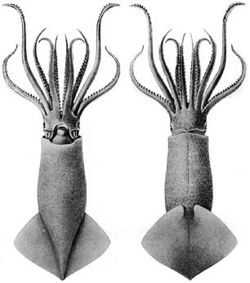Biology:Oegopsida
| Oegopsida | |
|---|---|

| |
| Moroteuthis ingens | |
| Scientific classification | |
| Domain: | Eukaryota |
| Kingdom: | Animalia |
| Phylum: | Mollusca |
| Class: | Cephalopoda |
| Superorder: | Decapodiformes |
| Order: | Oegopsida Orbigny, 1845[2] |
| Families | |
|
See text | |
| Synonyms | |
| |
Oegopsida is one of the two orders of squid in the superorder Decapodiformes, in the class Cephalopoda. Together with the Myopsina, it was formerly considered to be a suborder of the order Teuthida, in which case it was known as Oegopsina. This reclassification is due to Oegopsina and Myopsina not being demonstrated to form a clade.[3]
The Oegopsida are an often pelagic squid, with some nerito-oceanic species associated with sea mounts.[4] They consist of 24 families and 69 genera. They have these characters in common: the head is without tentacle pockets, eyes lack a corneal covering, arms and tentacle clubs may have hooks, the buccal supports are without suckers, and oviducts in females are paired.
Two families, the Bathyteuthidae and Chtenopterygidae, which have features characteristic of the Myopsida while retaining others common to the Oegopsina, were formerly placed in the family, but are now placed in their own order Bathyteuthida.[5]
The Oegopsida differ from the coastal Myopsida, characterised by the genus Loligo, which have corneal coverings over the eyes and tentacle pockets, but lack hooks, have no suckers on the buccal supports, and a single oviduct.
Oegopsid squid are the only decapods that lack a pocket for the tentacles. Otherwise, they share different characters with different decapod groups. Like the Bathyteuthida and Myopsida, the Oegopsida have a brachial canal, which is absent in other forms. As with the Spirulidae and Idiosepiidae, the Oegopsida lack suckers on the buccal supports, and like the Bathyteuthida, Idiosepiidae, and Spirulidae, they have no circular muscle on the suckers.
Evolution
The earliest fossils of Oegopsida are jaw fragments from the Santonian or early Campanian of the Yezo Group in Hokkaido, Japan . These jaw fragments are extremely large, suggesting that oegopsids could already evolve very large body sizes early on. One of these fossils was described as the genus Yezoteuthis, which has been estimated to rival the modern giant squid in size. Another jaw fragment described in 2023 was found to be twice as long as a giant squid's jaws.[1][6]
Taxonomy
The following taxonomic classification was found by Fernández-Álvarez et al., 2021:[5]
- Order Oegopsida
- Superfamily Architeuthoidea
- Family Architeuthidae
- Family Neoteuthidae
- Superfamily Cranchioidea
- Family Cranchiidae
- Family Ommastrephidae
- Family Thysanoteuthidae
- Superfamily Chiroteuthoidea
- Family Batoteuthidae
- Family Chiroteuthidae
- Family Joubiniteuthidae
- Family Magnapinnidae
- Family Mastigoteuthidae
- Family Promachoteuthidae
- Superfamily Cycloteuthoidea
- Family Brachioteuthidae
- Family Cycloteuthidae
- Superfamily Enoploteuthoidea
- Family Ancistrocheiridae
- Family Enoploteuthidae
- Family Lampadioteuthidae
- Family Lycoteuthidae
- Family Pyroteuthidae
- Superfamily Pholidoteuthoidea
- Family Pholidoteuthidae
- Superfamily Octopoteuthoidea
- Family Lepidoteuthidae
- Family Octopoteuthidae
- incertae sedis
- Family Gonatidae
- Family Histioteuthidae
- Family Onychoteuthidae
- Family Psychroteuthidae
- Genus †Yezoteuthis
- Superfamily Architeuthoidea
Phylogeny
The following phylogeny was found by Fernández-Álvarez et al., 2021:[5]
| Oegopsida |
| |||||||||||||||||||||||||||||||||||||||||||||||||||||||||||||||||||||||||||||||||||||||||||||||||||||||||||||||||||||||||||||||||
References
- ↑ 1.0 1.1 Tanabe, Kazushige; Hikida, Yoshinori; Iba, Yasuhiro (January 2006). "Two coleoid jaws from the Upper Cretaceous of Hokkaido, Japan" (in en). Journal of Paleontology 80 (1): 138–145. doi:10.1666/0022-3360(2006)080[0138:TCJFTU2.0.CO;2]. ISSN 0022-3360. https://www.cambridge.org/core/journals/journal-of-paleontology/article/abs/two-coleoid-jaws-from-the-upper-cretaceous-of-hokkaido-japan/E9AB99CDD77DBEF1736FF42771EB8E6B.
- ↑ Philippe Bouchet (2018). "Oegopsida". World Register of Marine Species. Flanders Marine Institute. http://www.marinespecies.org/aphia.php?p=taxdetails&id=11730.
- ↑ Jan M. Strugnell; Annie Lindgren; Louise M. Allcock (2009). "Cephalopod mollusks Cephalopoda". The Timetree of Life. OUP Oxford. pp. 2–18.
- ↑ P., Roper, Clyde F. E., 1937- Jereb (2010). Cephalopods of the world : an annotated and illustrated catalogue of cephalopod species known to date. Food and Agriculture Organization of the United Nations. ISBN 978-9251053836. OCLC 880299294. http://www.fao.org/docrep/014/i1920e/i1920e04.pdf.
- ↑ 5.0 5.1 5.2 Fernández-Álvarez, Fernando Ángel; Taite, Morag; Vecchione, Michael; Villanueva, Roger; Louise, Allcock. A phylogenomic look into the systematics of oceanic squids. doi:10.1093/zoolinnean/zlab069. https://academic.oup.com/zoolinnean/article/194/4/1212/6377132. Retrieved 2023-04-08.
- ↑ Tanabe, Kazushige; Misaki, Akihiro (2023-11-01). "Upper Cretaceous record of non-belemnitid coleoid jaws from Hokkaido, Japan, and its evolutionary implications". Cretaceous Research 151: 105624. doi:10.1016/j.cretres.2023.105624. ISSN 0195-6671. https://www.sciencedirect.com/science/article/pii/S0195667123001520.
External links
Wikidata ☰ Q639672 entry
 |

